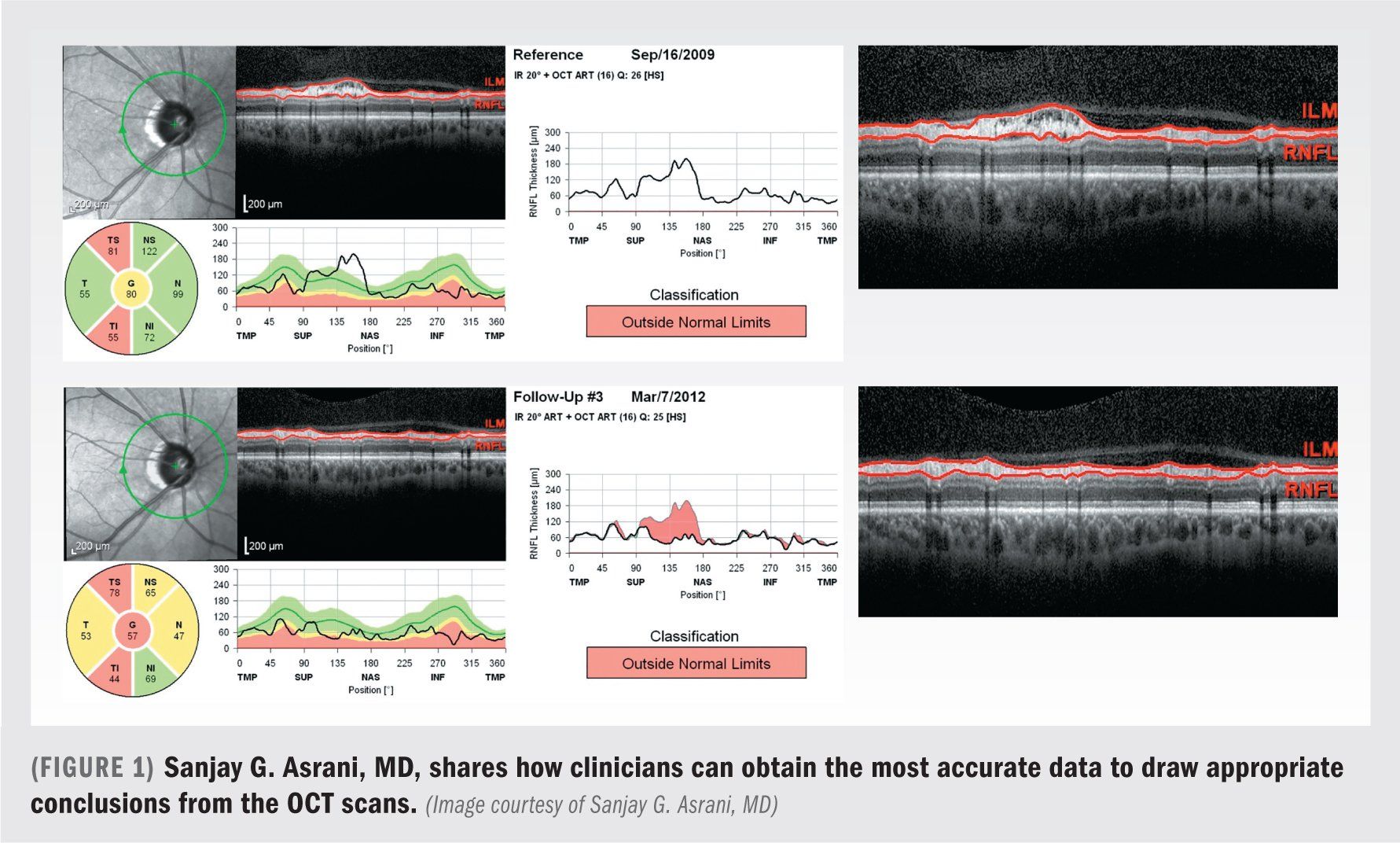Article
OCT finds niche in glaucoma diagnosis, management
Author(s):
Technology makes great tool, requires extra vigilance with co-existing disease

Physicians are increasingly relying on OCT to determine progression. It shows changes sooner and is an objective measure.
Reviewed by Sanjay G. Asrani, MD
Introduced nearly 30 years ago as a noninvasive technique for viewing the retina, optical coherence tomography (OCT) has established a definitive niche in the diagnosis and management of glaucoma.
“We are relying more and more on OCT to try to determine progression because, one it shows changes sooner than visual fields, and two, it is an objective measure, rather than a visual field, which is a semi-objective measure,” said Sanjay G. Asrani, MD, glaucoma specialist, Duke Eye Center, and professor of ophthalmology, Duke University, Durham, NC.
There are a number of steps clinicians can take to obtain the most accurate data and draw appropriate conclusions from the scans, Dr. Asrani explained.
Just as with visual fields, an important step is following a reliability checklist: make sure that the signal strength is good and that there is no tracking error; measure the slope of the retinal nerve fiber layer (RNFL) thickness over time to see if there is any unusual pattern of tissue loss; search for artifacts due to pathology; and determine if the RNFL loss matches the macular loss.
Dr. Asrani cautions clinicians against overreliance on the technology. “Do not accept the software interpretation of stability of progression,” he said. “Confirm by examining the raw image. It takes time, but we owe it to our patients.”
RNFL profile changes
The parameters for structural change include focal loss in the RNFL profile and the average thickness in the superotemporal or inferotemporal sectors. If the average thickness change is greater than 10 μm, then the progression is more likely to be real rather than an artifact. The other key parameter is total macular thickness. This is useful in all stages of glaucoma, but especially for advanced cases and in high myopes, Dr. Asrani said.
“In those two conditions, the other parameters are not easy to use for detection of progression,” he added. Macular features to watch for are a change in an arcuate shape and whether it corresponds to the loss on the RNFL. For example, imaging may show RNFL thinning over time and a drop in average thickness of the sector; however, the global average thickness may not be changing.
RELATED: Anti-VEGF expansion treats all DR stages“That is because there are certain areas where the RNFL appears to be slightly thicker, but that is averaged out and therefore the global average doesn’t change while the sectoral average does,” Dr. Asrani explained. “Try to confirm changes in the RNFL with macular thickness to be sure that the change is due to glaucoma,” he added. “If you are not sure, repeat the measurement in 4 months to confirm the changes.”
Another OCT pearl he shared is to use caution with coexisting pathologies and be extremely careful about the effects of vitreous on the retinal tissues. The epiretinal membrane can create a hyper-reflective band along the internal limiting membrane, making it seem that the RNFL is thicker than it actually is. Dr. Asrani pointed out that, in many cases, the vitreous traction pulls on the RNFL, causing it to become thicker.
“That gives you false reassurance that the patient’s glaucoma is not that bad because the nerve fiber layer appears normal in thickness,” he said. “But what happens is as the vitreous relaxes its traction on the nerve fiber layer, the nerve fiber layer thins out, and that appears like glaucoma progression. But when the nerve fiber layer changes do not match up with the macular changes, there is a high chance of an artifact.”
Other misinterpretation artifacts can also arise, and clinicians should consider whether a pattern of change is nonglaucomatous. For example, if RNFL thickness decreases dramatically from one visit to another, it may be due to non-arteritic ischemic optic neuropathy having developed in the interim, which can be identified if the thickness loss is only in one sector.
Misinterpretation is also possible when the RNFL is hollow because the axonal bundles have degenerated, leaving their sheaths intact and making the RNFL thickness seem normal. But when the structures collapse, the thickness drops dramatically.
However, this is not a “real” change, because the axonal loss was pre-existing, which is a very subtle difference to detect. Co-existing uveitis and glaucoma requires extra vigilance in interpreting OCT scans, Dr. Asrani noted.
“Because the RNFL is swollen, it appears thicker than it actually is, giving you a false sense of reassurance that the glaucoma is not bad,” he concluded. “As the inflammation is treated, the thickness of the RNFL significantly decreases, resulting in thinning that appears as if the glaucoma is getting worse. OCT must be used with extreme caution in patients with uveitis.”
RELATED: Intravenous prostaglandin E1 infusion for acute central retinal artery occlusion
Disclosures:
Sanjay G. Asrani, MD
P: 919/684-8656 E: sanjay.asrani@duke.com
This article was adapted from Dr. Asrani’s presentation at the 2019 meeting of the American Glaucoma Society. Dr. Asrani receives lecture honoraria from Heidelberg Engineering.
Newsletter
Don’t miss out—get Ophthalmology Times updates on the latest clinical advancements and expert interviews, straight to your inbox.




